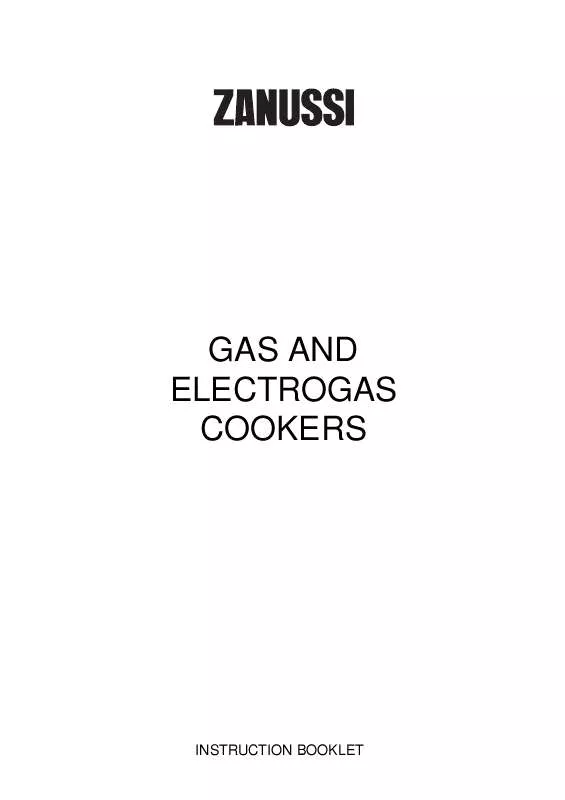Detailed instructions for use are in the User's Guide.
[. . . ] GAS AND ELECTROGAS COOKERS
INSTRUCTION BOOKLET
ENGLISH
IMPORTANT This new appliance is easy to use, however, to obtain the best results, it is important to read this booklet and to follow all the instructions before using it for the first time. The booklet contains the necessary information regarding installation, use and maintenance, as well as giving useful advice.
THE GUARANTEE
Your new cooker is covered by guarantee. You will find the guarantee certificate enclosed. If you are missing anything, contact your retailer, giving the date of purchase, model, and the registration number which is printed on the identification plate.
During cooking on the grill or in the oven, the unit is kept at a high temperature in relation to the plate glass door and adjacent parts. [. . . ] Remember to cover pans to reduce gas consumption.
12
SUGGESTIONS FOR THE USE OF THE OVEN
ADVICE FOR USE OF THE TRADITIONAL OVEN (GAS OR ELECTRIC)
For the cooking of cakes Pre-heat the oven , unless indicated differently, for at least 10 minutes before use. Do not open the oven door when cooking dishes which must raise (e. g. raised pastries and soufflés); the jet of cold air would block the raising process. To check if cakes are cooked, insert a toothpick into the mixture; if it comes out clean the cake is ready. Wait until at least 3/4 of the cooking time has passed before doing this check. As a general rule remember that: a dish which is well-cooked on the outside but not sufficiently cooked inside would have required a lower temperature and longer cooking time. On the contrary, a "dry" texture would have required a shorter time and higher cooking temperature. For the cooking of meat Meat to be cooked in the oven should weigh at least 1 kilo to avoid its becoming too dry. If you want roasts with a good colour, use very little oil. If the piece is lean, use oil or butter or a little of both. Butter or oil are on the other hand unnecessary if the piece has a strip of fat. If the piece has a strip of fat on one side only, put it in the oven with this side upwards; when melting the fat will grease the lower side sufficiently. Red meat should be removed from the fridge one hour before cooking otherwise the sudden change of temperature could cause it to become tough. A roast, especially if of red meat, must not be salted at the beginning of cooking as salt causes juices and blood to seep out of the òmeat, thus preventing the formation of a well-browned crust. It is advisable to salt the outside of the meat after just over half the cooking time. Place the roast in the oven in a dish having a low rim; a deep dish shields heat. Meat can be placed on an ovenproof dish or directly on the grill, under which the dripping pan will be inserted to collect juice. Ingredients for gravy should only be put in the dish immediately if cooking time is brief, otherwise they should be added during the last half hour. Begin cooking rare meat at a high temperature, reducing the temperature to finish cooking the inside. The cooking temperature for white meat can be moderate throughout. The degree of cooking can be checked by pressing the meat with a fork; if it does not give the meat is cooked. At the end of cooking it is advisable to wait at least 15 minutes before cutting the meat in order that the juices are not lost. [. . . ] 30) and take the oven burner out; c) with a socket spanner 7 unscrew and remove the nozzle, situated in the bottom of the oven, and replace it with the proper one (see Table 2); d) reassemble the burner following the same procedure backwards.
FO 0068
Fig. 29
Minimum level adjustment of oven burner After setting the oven on maximum temperature with closed door for about 10 minutes, turn the knob of the thermostat on 140, remove the knob and: -- in case of conversion from natural gas "H" to LPG, tightly screw the by-pass pin of the thermostat (Fig. 29); -- when converting from natural gas "H" to natural gas "S" unscrew the by-pass pin about one-fourth of a turn, until a regular small flame is reached.
Fig. 30
FO 1072
22
SPECIFICATIONS OF BURNERS AND INJECTORS
BURNER
NATURAL GAS "H" Injector m3/h (1/100) (15°C) kW
L. P. G.
G 30 kW
NATURAL GAS "S" Injector m3/h (1/100) (15°C) 124 100 71 116 0, 321 0, 210 0, 111 0, 299 kW
Injector g/h kW Injector g/h (1/100) (15°C) (1/100) (15°C) 86 71 50 82 202 137 72 209 2, 8 1, 9 1, 0 2, 9 86 71 50 82 204 138 73 211
Rapid Semi-rapid Auxiliary Gas Oven
112 92 70 105
0, 286 0, 181 0, 105 0, 257
3, 00 1, 9 1, 1 2, 7
2, 8 1, 9 1, 0 2, 9
2, 9 1, 9 1, 0 2, 7
Feeding pressure
25 mbar
30 mbar
30 mbar
25 mbar
WARNING If the pressure of gas used is different (or variable) from that foreseen , an appropriate pressure regulator must be installed on the entry tube. [. . . ]


